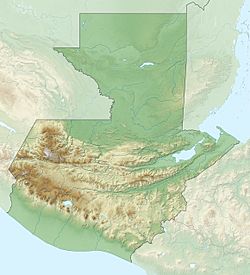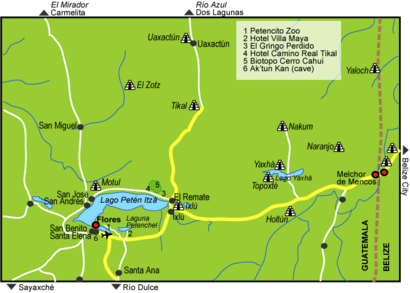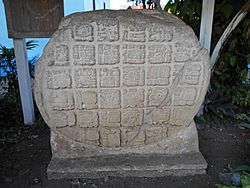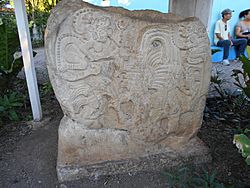Ixlu facts for kids
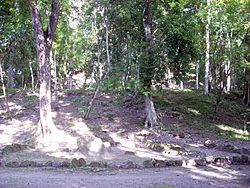
Unrestored architecture overlooking the Main Plaza
|
|
| Location | Flores |
|---|---|
| Region | Petén Department, Guatemala |
| Coordinates | 16°58′19″N 89°41′9″W / 16.97194°N 89.68583°W |
| History | |
| Periods | Classic - Postclassic |
| Cultures | Maya |
| Site notes | |
| Architecture | |
| Architectural styles | Classic and Postclassic Maya |
| Responsible body: Ministerio de Cultura y Deportes | |
Ixlu is a small ancient Maya site. It dates back to the Classic and Postclassic Periods. This means it was active from around 200 AD to 1525 AD. The site is located in northern Guatemala, between the Petén Itzá and Salpetén lakes.
Ixlu was an important port city. It had easy access to Lake Petén Itzá through the Ixlu River. Some experts believe Ixlu was actually Saklamakhal, a capital city of the Kowoj Maya people.
Archaeologists have found over 150 buildings at Ixlu. Most of the buildings in the main part of the site show features typical of the Postclassic Period. Don and Prudence Rice studied the site briefly in 1980.
Ixlu is about 23 km (14 mi) east of Flores. Flores is the capital of the Petén Department. The site is also about 275 km (171 mi) north of Guatemala City. It is located about 28 km (17 mi) south of the famous Maya city of Tikal.
Contents
When Was Ixlu Inhabited?
Archaeologists have found pieces of pottery at Ixlu. Some of these pieces date back to the early Middle Preclassic period (1000 BC–800 BC). This shows that people lived here a very long time ago.
Pottery from the Postclassic period (900 AD–1525 AD) is found widely. It is in the upper layers of the site, about 30 to 40 cm (12 to 16 in) deep. This means people lived here for a long time during this period.
Evidence from a building called the Temple of the Hidden Jars suggests continuous occupation. People lived at Ixlu from the Preclassic through the Classic (200 AD–900 AD) and into the Postclassic Period. They even stayed until about 1700 AD. This was well after the Spanish conquered most of Guatemala.
The Petén Lakes region finally came under Spanish rule in 1697. At that time, Ixlu was in an area claimed by both the Itza and Kowoj kingdoms. These two Maya groups were often in conflict.
What Structures Can Be Found at Ixlu?
The Central Peten Historical Ecology Project has mapped fifty structures at Ixlu. Nine of these are C-shaped bench buildings. Two others are L-shaped.
Ixlu has two ballcourts. It is one of only two Postclassic sites in the central Petén lakes region with a clear ballcourt. However, both ballcourts at Ixlu seem to be from the Late Classic period.
The site also has a twin pyramid complex. This type of building is rare outside of Tikal. It likely shows that Tikal, a very powerful city, had political influence over Ixlu.
The buildings at Ixlu look similar to those at Seibal. Seibal is another Late Classic site located on the Pasión River.
The Temple of the Hidden Jars
The Temple of the Hidden Jars is also known as Structure 2034. It is next to Structure 2041 on the south side. Structure 2036 is to the west, and Structure 2035 is to the north. Its east side faces Patio B.
The temple measures about 13.9 by 9.6 metres (46 by 31 ft). It had two levels. The first level was 1.15 metres (3.8 ft) high. The second level was 1.2 metres (3.9 ft) high. This temple was built during the Late Postclassic Period (1200 AD–1525 AD).
A staircase went up the west side of the temple. There was an altar on top, which measured 1 metre (3.3 ft). The temple gets its name from two hidden spots on its west side. One was at the bottom of the stairs. The second was under an altar on the temple steps.
Each hidden spot held a single red-brown ceramic jar. The jars were about 16 centimetres (6.3 in) wide and 14 centimetres (5.5 in) tall. Each jar had a concave lid. The jars had four handles around them, and the lids also had a handle. The jars only contained brown soil. This style of hidden spot is similar to those found in ceremonial buildings in Mayapan. Mayapan is far away in the northern Yucatán Peninsula.
Important Stone Monuments
Archaeologists found four carved stone monuments at Ixlu. These include two stelae (tall stone slabs) and two altars (carved stone blocks). These monuments are from the Classic Period.
Ixlu Stela 1 has a date carved on it: 879 AD. This is in the Late Classic Period. It shows a ruler who used the Tikal Emblem Glyph. This glyph means "holy lord of Tikal." The stelae at Ixlu look like traditional Classic Period stelae, similar to those at Tikal.
Both Stelae 1 and 2 show bloodletting rituals. They also show the appearance of the Paddler Gods. Ixlu Stela 2 is now in the main plaza of Flores.
The monuments at Ixlu have some hieroglyphic texts. These texts are very similar to texts found at the site of Dos Pilas. This suggests that the leaders of Ixlu might have been people who fled from Dos Pilas. Dos Pilas collapsed in the Petexbatún region. That state itself claimed to be the rightful rulers of Tikal.
See also
 In Spanish: Ixlú para niños
In Spanish: Ixlú para niños
- Topoxte
- List of Maya sites


